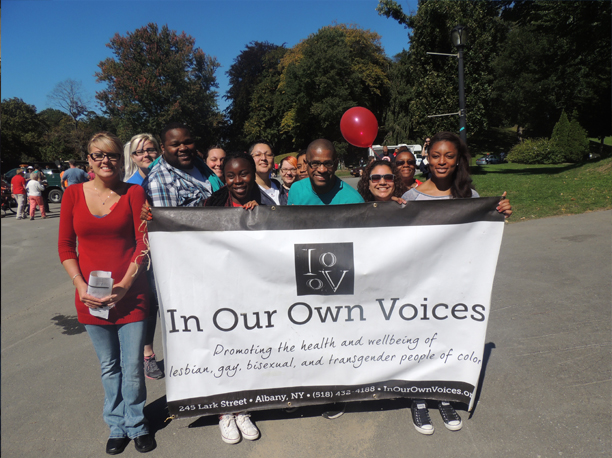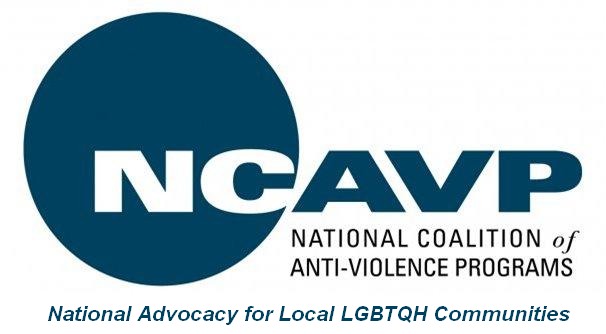Partner abuse is widely misunderstood and underreported in the queer community. In large part, this stems from a widespread misconception that partner abuse only affects straight couples where the male partner abuses the female partner. This is a myth — in fact, queer intimate partner violence is happening all the time — but it continues to be exclusively reflected in resources and mainstream responses to partner abuse across the United States. For instance, there was the judge in Ohio who didn’t believe abuse could occur between same-sex partners. And the specific challenges that queer people face when trying to get help about intimate partner violence are on top of the already challenging situation that ALL survivors face.
Mainstream responses to partner abuse create huge obstacles for LGBTQ people. These resources don’t address how other forms of violence affect the queer community, and they are often institutionally homo/bi/transphobic, racist, classist and ableist. They are also often tied to systems of law enforcement, which can make them actively unsafe for LGBTQ people to utilize. The real possibility of violence, either on oneself or one’s partner, or revictimization through homo/bi/transphobia, racism, or ignorance of queer and trans* issues, deter people from seeking help.

Phillip Burse, Director of LGBT Victim Services for In Our Own Voices (IOOV), an organization doing anti-violence work, advocacy and community organizing with LGBT people of color in Albany, New York, elaborated on why mainstream organizations with reductive ideas about partner abuse fall short:
“if we’re looking at the LGBT community or LGBT communities of color who face additional barriers, they’re trying to navigate a system designed primarily by heterosexual, white, middle-income folks- they aren’t designed with the LGBT community’s interests in mind… We know that LGBT victims of domestic violence (and other crimes) are coming through the door with centuries of trauma, transgenerational trauma – the effects of slavery, the effects of segregation, Jim Crow – those types of trauma lives in people’s bodies… and will transfer from generation to generation manifesting itself physically and/or mentally.”
Organizations around the U.S. like IOOV have grown out of the need for a specifically queer response to partner abuse, which understands that the barriers people in abusive partnerships face are related to issues that are bigger than the relationship. They envision an end to all violence faced by queer people.
Katie Atkins is Community Programs Coordinator for The Network/La Red (TNLR), a Boston-based bilingual organization working to end partner abuse in the LGBQ/T, SM, and poly communities. Atkins pointed out that in order to end partner abuse, we need to be addressing oppression on a scale far beyond the interactions of the two people involved:
“The Network sees partner abuse as part of a larger framework… connected to institutional and structural forms of oppression and violence. To end one form of oppression – partner abuse – we believe we have to work to end all forms of oppression. …we believe that, in addition to sexism, partner abuse is rooted in other forms of oppression as well, like homo/bi/transphobia, racism, classism, ableism, etc. all coming together.”
To address this massive web of oppression, TNLR has a set of principles to guide their work that understand oppression and partner abuse as power imbalances in which someone or some group has non-consensual power over another – the non-consensual aspect is key, as TNLR recognizes that consensual power exchange within SM scenes and partnerships is not abuse.
![via [TNLR Facebook Page https://www.facebook.com/tnlrtnlr]](https://develop.autostraddle.com/wp-content/uploads/2013/12/TNLR.jpg?resize=640%2C480)
“Part of why being survivor-led is important is because we don’t want to replicate the power dynamics that someone has experienced in their abusive relationship… we want to be sharing power. To do that, we need to approach the work with an understanding that each survivor is the expert on their own experience, and what works for one person (or what worked for yourself) may not work for everyone. Our role is not to tell people what they should or shouldn’t do, it’s much more of a support role.”
When survivors take the lead in forming the response to their situations, they have the power to determine which resources they feel safe making use of. This is particularly important when “traditional” resources like the court system and the shelter system can create more problems than they solve for queer people, particularly for trans* and queer people of color. Queer and trans* people of color are disproportionately affected by police violence, and the expectation of further violence resulting from police intervention can be a huge deterrent for seeking assistance. The shelter system is also often not equipped to create a safe environment for trans* people, people in same-sex partnerships or non-English speakers. When an organization is LGBTQ-specific, culturally specific and survivor-led, a survivor can know they won’t be silenced, blamed or revictimized for their identity, and that they will be able to seek assistance safely.
Culturally specific and survivor-led resources for queer survivors of partner abuse openly recognize cultural and institutional barriers to survivors’ needs. Whether out of fear for one’s own safety, or for the safety of an abusive partner, if a survivor feels unsafe seeking assistance from the court or shelter systems, there are alternatives. Burse elaborated on how IOOV works with people who do not want to utilize mainstream systems:
“Due to the historical and present day injustices involving LGBT/POC and the criminal justice system, We understand that victims may not want to report the violence to the police… if a victim does not feel comfortable doing that, we work with them anyway to provide support, safety planning, mental health support and more. We know it might not be possible to leave the relationship at the moment, so what strategies can we develop to attempt to reduce your harm?”
Atkins discussed safety planning as an alternative: “It really depends on individual situations and what people are looking for, but if someone is worried about [utilizing the court system] we would never push them to do so and can brainstorm and strategize about how to achieve what they want to achieve without those systems.” She also pointed out that if a survivor decides they do want to utilize the courts, there are ways of safety planning for what might happen while taking that course of action.
Both TNLR and IOOV work with mainstream organizations to help them become more inclusive and safer for queer people to utilize. IOOV works with organizations to help them improve their cultural competency. TNLR offers a free manual available upon request, and can provide trainings to help organizations learn about different communities, use appropriate language and resist making assumptions about people’s identities. The Anti-Violence Project Training and Technical Assistance Center also offers resources for mainstream organizations.

If you’re looking for more organizations like IOOV and TNLR, there are many other queer community organizations working within an anti-oppression/social justice framework around the U.S. The National Coalition of Anti-Violence Programs is a coalition of groups “dedicated to reducing violence and its impacts on lesbian, gay, bisexual, transgender, queer, and HIV-affected (LGBTQH) communities.” They have member groups around the U.S. and Canada. [PDF] Some of these are specific to communities of color, and some are specific to partner abuse.
Organizations operating outside the mainstream also encounter many of their own barriers. Funding is a huge issue for organizations like TNLR and IOOV because the non-profit system (sometimes referred to as the non-profit industrial complex) expects them to fund themselves through private foundations and government programs. Grants are difficult to obtain for culturally-specific and survivor-led resources because the institutions which distribute them are not typically invested in community responses to violence that do not engage mainstream institutions like the criminal justice system.

Recognizing partner abuse as connected to larger structures of violence creates a framework to respond to abuse in meaningful and empowering ways. Ending the violence faced by the queer community is not a simple goal, but creating organizations that support and reflect our needs can help us move towards achieving it.








Comments
I am so happy to see TNLR featured here! They are a great organization.
As a member of the community of bi/pan/fluid women and female-interpreted genderqueers, I want to point out that according to the CDC we are more likely than either lesbian or straight women to experience intimate partner violence, MUCH more likely to experience rape or “severe” physical violence from an intimate partner, MUCH more likely to experience PTSD symptoms from the intimate partner violence, and more likely to experience some sort of negative life impact as a result of the intimate partner violence.
The hugely disproportionate impact of intimate partner violence on bi/pan/fluid women and genderqueers is something that I feel bi-serving organizations should be addressing, and something that more queer people (including more bi/pan/fluid people) should recognize.
I definitely learned a lot from this article, I’m glad to hear that these organizations exist.
me too! I’d be interested to know if there are similar organisations in europe.
I love the proactive nature of the queer community and how we find solutions to our own problems. The more that I’ve read about the domestic violence issues within LGBT couples(stats are on par with cis hetero couples – 1 in 4) the more I’ve realized just how badly such organizations are needed. As far as LGBT rights have come in US society there is still such a distance to go and when such domestic situations arise it is relieving to think there would be another avenue to explore solutions as opposed to involving law enforcement and typically exacerbating the problem.
Yes! I’m kind of tangentially involved in an collective aimed at creating alternatives to police power, so I will definitely be reading the safety planning literature mentioned here.
Oops, that was meant to be a reply to @Jess
Another good resource for safety planning (aimed at teens, but the ideas could be tweaked for adults as well) is the National Dating Abuse Helpline’s safety planning page: http://www.loveisrespect.org/get-help/safety-planning
Great resource! Thank you for sharing it!!
That was great, very informative
Thanks Maddie
This is wonderful. I tip my hat to the people involved in these organizations. Not only do they have to have the dedication that any volunteer/service workers need, but they also have such great creativity to come up with new approaches to the problem and to figure out how to effectively work around problematic law enforcement systems and traditional organizations.
I also like the emphasis on local, community-based solutions. There is so much diversity in this country, there is no one size fits all solution.
AS more of this!